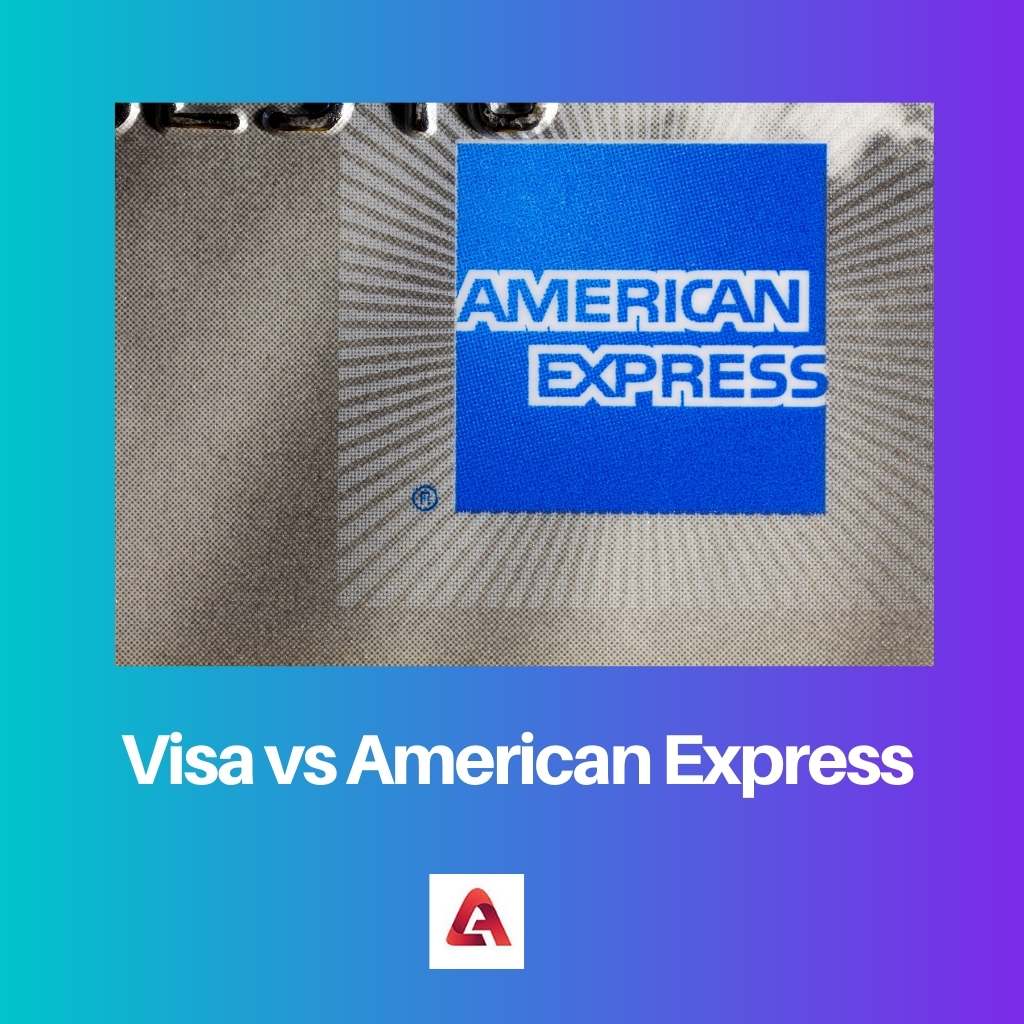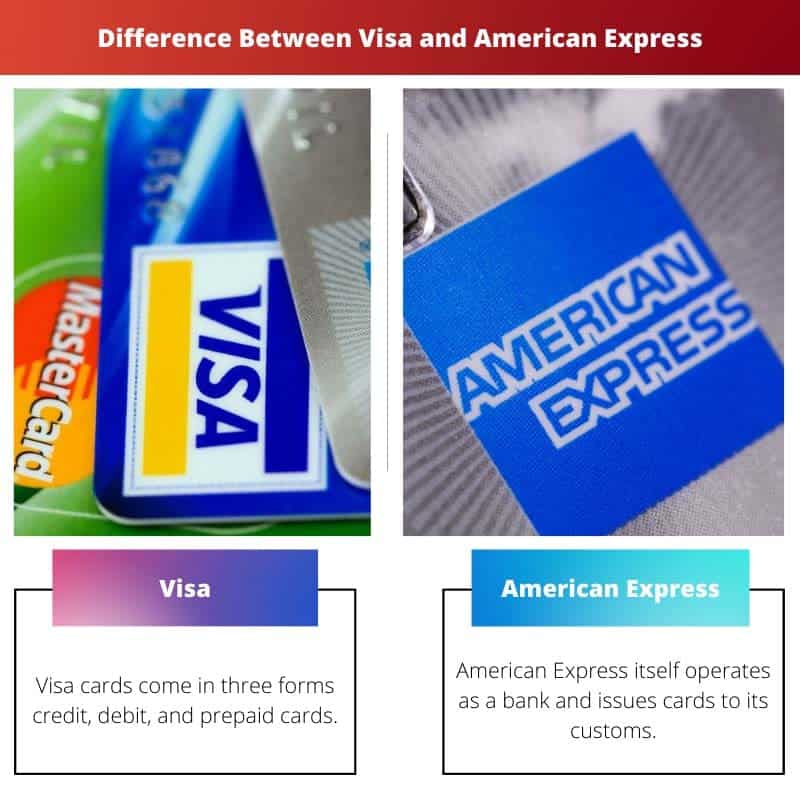A credit card is a financial tool that provides loans and debt to its consumers and allows them to repay the provider in future data through installments. Credit cards let consumers make purchases everywhere and at any time without carrying any cash. Visa and American Express credit cards are accepted in many countries. These cards provide similar services but differ in merchant fees.
Key Takeaways
- Visa operates as a payment processor, while American Express is an issuer and payment processor.
- American Express charges merchants higher fees, leading to its acceptance in fewer locations.
- Visa offers more extensive global acceptance, making it more convenient for international travelers.
Visa vs American Express
Visa is a credit card network that works with financial institutions to provide credit and debit cards to consumers. American Express is a financial services company that issues its own credit cards and operates its own payment network, offering cardholders a range of benefits such as rewards programs, and exclusive access to events.

Visa cards come in three forms credit, debit, and prepaid cards. These cards are issued by other banks like Bank of America, Chase, Capital One, and others. It has various schemes and rewards for its customers. It provides different types of cards like Visa Classic, Gold, Platinum, Infinite, and Signature that provide rewards and benefits to different customer categories.
American Express itself operates as a bank and issues cards to its customers. It has seven different card types based on the annual income range of its customers. Each card provides various benefits and rewards. They are American Express platinum card, Gold, Membership reward card, smart earn credit card, platinum reserve credit card, platinum card, and platinum travel card. It is only accepted in a few countries.
Comparison Table
| Parameters of Comparison | Visa | American Express |
| Type of Company | Visa is a global payment technology company that processes payments among banks, financial institutes, and customers. | American Express is a financial and travel services corporation in America that issues cards as well as processes payments. |
| Headquarter | San Fransico, United States | New York, United States |
| Founder | Dee Hock | William Fargo, John Butterfield, and Henry Wells |
| International Acceptance | Worldwide | It is accepted only in 130 plus countries. |
| Eligibility criteria | It has flexible eligibility criteria to attract small, and large corporations. | It has strict criteria and only rich people can afford it. |
What is Visa?
The Visa company was started in 1958 by Dee Hock when Bank of America started a credit card program for small and medium-sized organizations. It then expanded internationally in 1974. It has acquired Visa Europe. Earlier, Visa was known as BankAmericaCard. Today, Visa is accepted in two hundred-plus countries and territories. It provides many banking services and products. It also provides online services to its customers.
It has a mobile platform that allows its customers and merchants to process their transactions with ease. Visa is a payment processing company that charges different fees based on the card issuer’s policies. Bank of America, Capital One, Chase, SBI, and others are top Visa Card issuers. It distributes card types like Visa Gold, Platinum, Infinite, Classic, and Signature, with attractive rewards, credits, insurance, and other benefits. Visa card is widely accepted cards and helps customers to go cashless everywhere.
Visa also act socially responsible by providing free education and services to small and medium-sized organizations and helping them grow their business. It empowers women by allowing them to do business with financial support. It uses Artificial intelligence and neural network technologies to reduce card fraud and protect consumer data from cyber attacks.

What is American Express?
American Express was started in 1850 as a freight forwarding company. Later in 1950, it began to provide financial services and travel services. It made purchases convenient through its credit card. American Express is a widely accepted payment and credit card issuing company. It also initiated a small business payment network to support small business owners and provided them with offers to grow their businesses.
In 2010, the company started to encourage Americans to shop in small businesses and offered them rewards through Small Business Saturday. The American Express schemes and reward programs benefit both the customers and merchants. By 2017, it had adopted IT technologies and created an application to allow its customers to process transactions online. It has created many digital initiatives to improve its services and reach global customers.
American Express provides similar services to its customers as other cards, but it charges more initiation fees. There is a high chance to earn reward points, but at the same time, these rewards will be of no use because of annual fees. Many merchants do not accept American Express, and only high-status people can afford it. American Express provides guidance, insurance, and protection from fraud to its customers.

Main Differences Between Visa and American Express
- Visa is a payment processing company that acts as a medium for banks, merchants, and customers. On the other hand, American Express is a financial service provider and card issuer that provides travel packages to its customers.
- Visa charges processing fees based on its merchants and is less compared to American Express.
- Visa charges low-interest rates to help small and medium-sized organizations to grow their business, While American Express charges high-interest rates.
- Visa is accepted by global merchants worldwide compared to American Express.
- Visa provides concierge services to its customers, whereas American Express provides this service only to premium credit cardholders.


This insightful article provides an in-depth analysis of the features and services offered by both Visa and American Express. It brings clarity to the distinguishing factors between the two credit card networks.
The social responsibility initiatives undertaken by Visa and American Express, as highlighted in the article, emphasize their commitment to supporting businesses and contributing to women’s empowerment.
The comparison of eligibility criteria between Visa and American Express provides an interesting perspective on their target customer segments, reflecting their distinct market positioning.
The article’s emphasis on the technological advancements and digital initiatives of American Express demonstrates the company’s dedication to enhancing customer experiences through innovative solutions.
The historical background and evolution of both Visa and American Express are fascinating and enriching to understand the roots of these financial institutions. Well-researched content.
The detailed breakdown of Visa and American Express operations is informative, shedding light on the differences in their corporate structures and global acceptance. Well-articulated content.
The comparison table presented here effectively identifies the essential differences between Visa and American Express, making it easier for consumers to understand the nuances of these credit card providers.
The comparison of the main differences between Visa and American Express effectively outlines their diverse services and offerings, enabling readers to grasp the unique features of each credit card network.